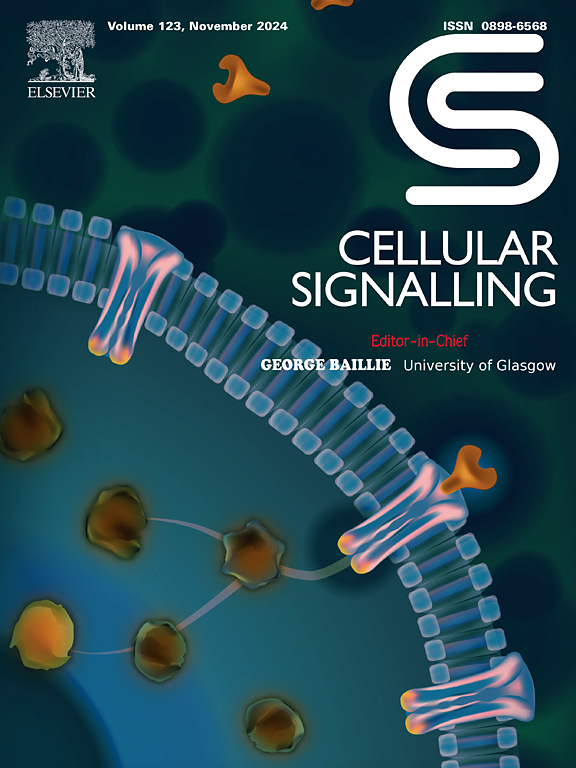成纤维细胞衍生的 versican 通过调节巨噬细胞迁移和炎性细胞因子分泌加剧牙周炎的发展。
IF 4.4
2区 生物学
Q2 CELL BIOLOGY
引用次数: 0
摘要
目的:Versican (VCAN)是一种在炎症性疾病中上调的重要细胞外基质成分,它显示了环境特异性的调节机制。牙周炎是一种导致牙周组织破坏和牙齿脱落的慢性炎症性疾病,其病理作用仍不明确。本研究旨在探讨vcan介导的牙周炎机制。方法:我们对大量RNA测序和单细胞RNA测序数据进行了综合分析,以检测牙周炎中VCAN的表达水平和来源。通过功能分析和相关分析探讨其生物学功能。随后,我们利用实时定量聚合酶链反应、免疫组织化学染色和免疫荧光染色在动物模型上验证了VCAN的表达,并通过体外实验研究了其在炎症中的生物学功能。结果:我们的研究结果表明,VCAN主要由牙周炎成纤维细胞产生,其mRNA和蛋白水平均显著上调。使用过表达vcan的L929细胞,我们证明了增强的增殖能力和炎症潜能。RAW264.7细胞共培养实验显示,细胞的迁移、粘附、M1极化和丝裂原活化蛋白激酶(MAPK)通路激活均得到促进。结论:VCAN促进成纤维细胞增殖和迁移,从而提高炎症因子的产生。此外,成纤维细胞衍生的VCAN不仅诱导巨噬细胞趋化、迁移、粘附和向促炎M1表型的极化,而且还激活巨噬细胞的MAPK信号,这可能会放大炎症级联反应,加剧牙周组织的破坏。靶向调控VCAN表达可能成为牙周炎的一种有前景的精准治疗策略。本文章由计算机程序翻译,如有差异,请以英文原文为准。
Fibroblast-derived versican exacerbates periodontitis progression by regulating macrophage migration and inflammatory cytokine secretion
Objective
Versican (VCAN), a prominent extracellular matrix component upregulated in inflammatory diseases, demonstrates context-specific regulatory mechanisms. Periodontitis, a chronic inflammatory disease leading to periodontal tissue destruction and tooth loss, the pathological role of it remains poorly defined. Our study aims to examine VCAN-mediated mechanisms in periodontitis.
Methods
We conducted a comprehensive analysis of bulk RNA sequencing and single-cell RNA sequencing data to examine VCAN expression level and source in periodontitis. Functional and correlation analyses were used to explore its biological functions. We then validated VCAN expression using quantitative real-time polymerase chain reaction, immunohistochemical staining, and immunofluorescence staining in animal models and investigated its biological functions in inflammation through in vitro experiments.
Results
Our findings reveal that VCAN is mainly generated by fibroblast in periodontitis, and its expression significantly upregulated at both mRNA and protein levels. Using VCAN-overexpressing L929 cells, we demonstrated enhanced proliferative capacity and inflammatory potential. Co-culture experiments with RAW264.7 cells showed promoted migration, adhesion, M1 polarization, and mitogen-activated protein kinase (MAPK) pathway activation.
Conclusion
VCAN enhances fibroblast proliferation and migration, and upregulates inflammatory cytokines expression. Furthermore, fibroblast-derived VCAN not only induces macrophage chemotaxis, migration, adhesion, and polarization toward the proinflammatory M1 phenotype, but also activates MAPK signaling of macrophage, which may amplify inflammatory cascades to exacerbate periodontal tissue destruction. Targeted regulation of VCAN expression may become a promising precision treatment strategy for periodontitis.
求助全文
通过发布文献求助,成功后即可免费获取论文全文。
去求助
来源期刊

Cellular signalling
生物-细胞生物学
CiteScore
8.40
自引率
0.00%
发文量
250
审稿时长
27 days
期刊介绍:
Cellular Signalling publishes original research describing fundamental and clinical findings on the mechanisms, actions and structural components of cellular signalling systems in vitro and in vivo.
Cellular Signalling aims at full length research papers defining signalling systems ranging from microorganisms to cells, tissues and higher organisms.
 求助内容:
求助内容: 应助结果提醒方式:
应助结果提醒方式:


